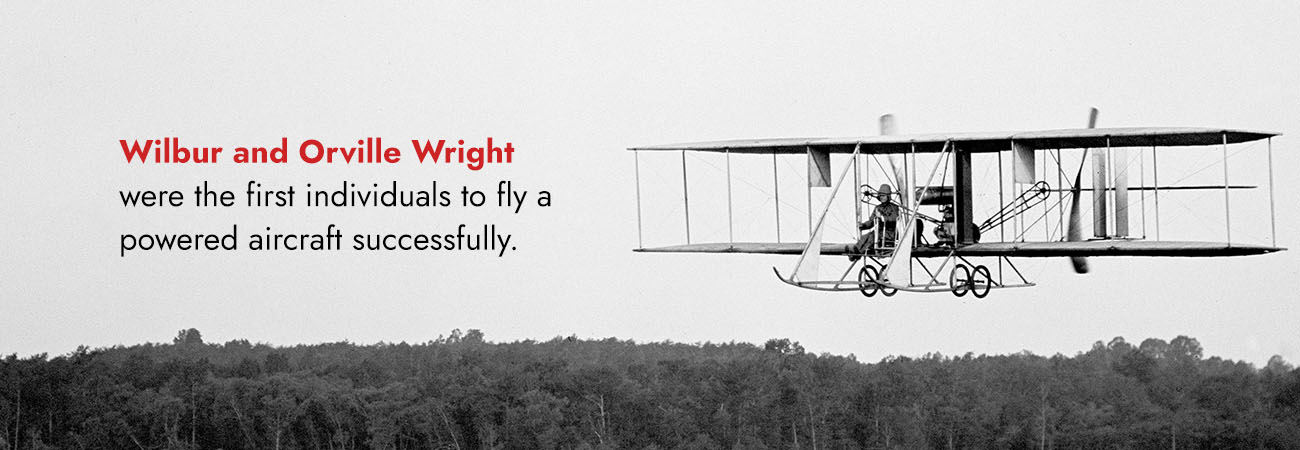
The History of Aviation | Volo Museum

The Evolution of Aviation
The fascinating history of aviation reveals the human race's determination, creativity and intelligence surrounding flight. From early aerodynamics theories to combat aircraft innovations and famous jets in film, aviation has a long history.
Experience the Fascinating History of Planes
While most individuals learn the basics of history in school, nothing compares to seeing antique planes and jets in person. Experience the evolution of aviation by visiting real planes and replicas used in combat or featured in your favorite films. When you visit aviation exhibits, you and your family can discover what it feels like to stand next to a World War II plane or take a picture next to the same jet Arnold Schwarzenegger flew in “True Lies.”
Pre-Flight Ideas and Innovations
Various ideas, inventions and trials and errors contributed to aviation's advancement around the world. The following concepts inspired innovations in aviation:
- Greek mythology: Greek mythology features gods who could fly, revealing that humans have always been curious about flight.
- Leonardo da Vinci's sketches: Da Vinci explored and analyzed basic principles of physics and aerodynamics in his sketches. He also wrote and sketched about the challenges of aeronautics such as wing structure, landing gear and directional control devices.
- Hot air balloons: In 1783, the Montgolfier brothers designed the first hot air balloon capable of sustaining flight while carrying humans. Tethered balloons eventually became helpful during the American Civil War when troops would use them to monitor battlefields.
- Dirigibles: A dirigible was a propeller-powered airship with a rigid internal frame. Henri Giffard built the first dirigible in 1852, which eventually led to the development of modern blimps.
Inventive and Scientific Developments
Numerous inventive and scientific developments led to the aircraft we read about in history books and the ones we use today. It's impossible to claim one individual invented the first aircraft because several people contributed inventions and scientific discoveries to its evolution.
Many early aircraft developments were inventive or intuition-based, meaning individuals tested ideas without technical training. As time went on, trained individuals used systematic, scientific-based approaches to further develop aircraft design and function. Most aircraft developments in the 19th century were inventive. Someone would build something and attempt to fly it, resulting in odd, unsuccessful contraptions. At the beginning of the 20th century, trained individuals took a more scientific approach to the following aircraft essentials:
- Aerodynamics: Flight innovators began to understand the importance of power and wing size to sustain a flight. Mathematician and physicist Isaac Newton helped develop aerodynamic theory by exploring laws of motion and the force a stream of air has on a wing. Using Newton's laws of motion, inventors and scientists eventually discovered that aircraft wings needed a specific size, weight and strength to fly.
- Proper weight and strength: Scientists discovered that lighter materials and engines were necessary to achieve the proper weight and structural strength for flight. Developers began using aluminum in aircraft construction applications around 1915.
- Stability and control: Early aircraft inventions often crashed because inventors didn't know how important gravity and aerodynamic lift were for flight stability. Over the span of several decades, scientists began to develop effective control surfaces based on an aircraft's center of gravity and aerodynamic lift.
- Propellers: Developing efficient propellers also took decades of scientific discoveries and processes. Early propellers typically resembled the shapes of oars or ship propellers, but scientists developed effective blade shapes over time.
While inventive and scientific flight developments were vastly different, they all had a significant impact on the aircraft we see and use today.
Early Aircraft Concepts
The following individuals developed some of the earliest aircraft concepts during the early 19th century:
- George Cayley: As a scientist, George Cayley proposed several aircraft concepts such as gliders, airplanes and an early helicopter. His concepts featured vertical and horizontal tail surfaces to increase directional control and stability, and he helped increase the industry's understanding of how aerodynamics affect flight stability. Cayley also discovered the four forces responsible for flight, which are thrust, weight, lift and drag.
- Otto Lilienthal: Otto Lilienthal developed various glider concepts and conducted numerous flights by the start of the 20th century.
- Octave Chanute: Octave Chanute continued Lilenthal's developments and wrote books on his discoveries and experiences. Chanute eventually shared his knowledge with the Wright brothers, helping them develop advanced flight machine designs.
First Powered Aircraft Flight

Wilbur and Orville Wright were the first individuals to fly a powered aircraft successfully. In December of 1903, they flew the first powered biplane to take off and land under a pilot's control. The Wright brothers designed and built the plane's frame, propellers and engine based on their understanding of an aircraft's essential components.
by 1908, the Wright brothers developed an aircraft that could fly approximately 100 miles and remain in flight for more than two hours. The Wright brothers' successful designs paved the way for flight technology to advance, leading to jet engines, World War I and World War II planes and the planes we use today.
The Aviation Boom of World War I and World War II
Several aircraft advancements occurred during World War I and World War II, paving the way for planes, jets and helicopters to become faster, more powerful and incredibly useful. The following flight innovations developed during these pivotal times in history:
Propeller and Engine Advancements
In their designs and successful flights, the Wright brothers revealed that plane propellers need large aspect ratio blades with nose-down twists for efficient propulsion. As aircraft designs advanced, manufacturers built planes with a more raked propeller design, creating a wider surface area toward each blade's tip. This innovation further increased efficiency, allowing engines to convert more power into thrust so planes could travel farther distances.
Early rotary engines caused control and stability complications, so manufacturers began building planes with piston engines such as radial, V and in-line forms.
Lightweight Frame Structures
Aircraft manufacturers developed lightweight airframe structures by the 1930s, which increased an aircraft's ability to carry heavier payloads and fly longer distances. Airframes also increased in strength during this time period as manufacturers began using aluminum to build airframes.
Specialized Fighting Capabilities
At the beginning of World War I, troops used planes for unarmed observation, monitoring and tracking enemy troop movements. However, planes quickly evolved into weapons of war. By the end of World War I, many planes featured synchronization and interrupter gear that enabled pilots to aim front-mounted machine guns at enemy aircraft. With this gear, pilots could shoot continuous streams of bullets through rotating propeller blades without damaging the aircraft.
Jet-Powered Aircraft
Enemy forces' aggressive air strikes during World War II forced manufacturers to produce faster, stronger and more powerful aircraft to fight back. Companies worked hard during World War II to improve long-range bombers, increase plane speed and reduce fuel consumption. A large part of these efforts was the development of jet-powered aircraft. Jet engines are compact and incredibly powerful, and they drove aviation innovation toward the end of the war.
Famous Aircraft Throughout History
The Volo Auto Museum is proud to feature various aircraft that played an important role in history. You can explore our aviation exhibit to learn more about the following jets, planes and helicopters:

Vertical Take-Off and Landing (VTOL) Harrier Jump Jet
The Harrier jump jet was the first vertical take-off and landing (VTOL) aircraft. Hawker Siddeley first began working on a vertical take-off plane in 1957, and he flew one of his first prototypes in 1960. An improved version of this prototype was known as the Kestrel, and it first took flight in 1964. By 1967, the Royal Air Force evaluated the Kestrel and ordered an upgraded version of it before renaming it the Harrier.
A pilot can quickly transition a Harrier's thrust from a standard horizontal flying position to a straight-down position, and they can hover it in mid-air. With this flexibility, they can take off from or land on aircraft carrier ships, highways, short strips and woodland areas. Harrier jump jets were instrumental in several combat situations, including:
- Cold War: During the Cold War, the Harrier was a solution for limited basing options. When enemy forces bombed runways, the Harrier could still take off and land to take over for conventional aircraft when necessary.
- Falklands War: The Harrier's ability to take off from and land on various bases made it useful during the Falklands War when troops could only reach the fight by sea.
- Afghanistan: The Harrier was also useful for troops fighting in Afghanistan because it enabled them to fly through very thin, hot air effectively.
The Harrier jump jet is also easy to hide in wooded areas, and it has excellent fighting capabilities. It can carry the following types of weapons and ammunition for combat:
- Bombs
- Rockets
- Guided air-to-surface anti-ship missiles
- Air-to-air missiles
The Fouga Magister
The French military first developed the Fouga Magister jet model during the 1950s for training purposes, and they only built about 900 of them. A Fouga Magister could reach a top speed of 444 miles per hour, and the French military used it to train new pilots because it had a more powerful engine than previous trainer jets.
Volo Auto Museum received a donated Fouga Magister from the Watkins family out of Texas, so you can learn more about this important piece of history when you explore the aviation exhibit.
Vietnam VIP Huey Helicopter
The United States military nicknamed the Huey helicopter after its original name, HU-1. During the Vietnam War, the military used the Huey helicopter for various purposes such as medical evacuation, resupply transports, combat gun support, search and rescue, direct enemy engagement and soldier transportation.

At the Volo Auto Museum, you can see a Huey helicopter up close. This model served as a VIP transport aircraft during the Vietnam War, so it has a glossy paint finish that the military used to distinguish between combat and VIP transport aircraft.
Shot-Down World War II Plane
The Volo Auto Museum also features a shot-down World War II plane. A salvaged and restored cockpit is on display so you can learn more about the incredible aircraft troops used during the war.
Kellett KH-15 "Stable Mable"
The Kellett Aircraft Corp. designed and built the Kellett KH-15 helicopter prototype in 1954. The company powered this single-seat prototype with rocket technology and used it to study a small helicopter's behavior while altering the rotor's parameters. You can see the incredible one-man helicopter when you visit Volo Auto Museum's aviation exhibit.
Aircraft in Film
Aircraft has been an important part of films for nearly a century. From early silent films such as “Wings” in 1927 to the Marvel movies we enjoy today, producers have included planes and jets in their visual storytelling. Consider how aircraft have impacted the following famous movies:
“True Lies”
The film, "True Lies," is a 1994 action comedy film starring Arnold Schwarzenegger. In one of this film's most exciting scenes, Schwarzenegger's character fights two enemies while flying a McDonnell Douglas AV-8B Harrier II jet.
The movie features real Harrier jets flying overhead, but it also features an exact replica of an AV-8B Harrier II jet. Hanging this fiberglass replica from a crane, special effects crews were able to make it look like Schwarzenegger was flying the plane in the air himself. Using this replica enabled the film crew to include several exhilarating action scenes involving actors fighting on top of the plane, hanging onto the front of it and breaking a skyscraper window while in the air.
The McDonnell Douglas AV-8B Harrier II replica currently resides in the Volo Auto Museum, and you can see this exciting part of aviation and film history up close when you visit.
“Avengers”
You may also recognize the McDonnell Douglas AV-8B Harrier II replica from Marvel's 2012 “Avengers” film. The replica remained parked in a desert for several years after it appeared in the “True Lies” film, and Hollywood decided to reuse it for “Avengers.” In this film, The Hulk smashes part of the plane and throws it at Thor. During this scene, the actors and crew really did break part of the replica, ripping the tear-away wing off and leaving the jet in pieces.
Volo's team completed a full restoration of the Harrier jet replica, piecing it back together and hand-making some of the missing components. Since two different movies featured the jet, the Volo team re-painted half of it to match how it looked in “True Lies” and the other half to resemble how it looked in “Avengers.” This way, fans of each movie can visit and snap some photos with a well-known movie prop.
Discover Incredible Aviation History at Volo Auto Museum
The evolution of aviation is a significant part of US and world history. Volo Auto Museum is excited to share antique planes, jets and helicopters with you so you can step back in history. From World War II to the exhilarating world of “Avengers," our aviation exhibit features some of the most interesting parts of flight history. Plan your visit today to expand your aviation knowledge.


